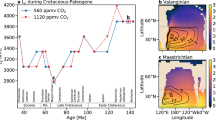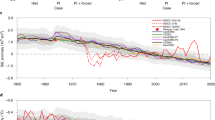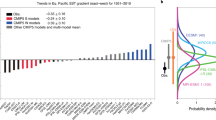Abstract
The Indo-Pacific warm pool—the main source of heat and moisture to the global atmosphere—plays a prominent role in tropical and global climate variability. During the Last Glacial Maximum, temperatures within the warm pool were cooler than today and precipitation patterns were altered, but the mechanism responsible for these shifts remains unclear. Here we use a synthesis of proxy reconstructions of warm pool hydrology and a multi-model ensemble of climate simulations to assess the drivers of these changes. The proxy data suggest drier conditions throughout the centre of the warm pool and wetter conditions in the western Indian and Pacific oceans. Only one model out of twelve simulates a pattern of hydroclimate change similar to our reconstructions, as measured by the Cohen’s κ statistic. Exposure of the Sunda Shelf by lower glacial sea level plays a key role in the hydrologic pattern simulated by this model, which results from changes in the Walker circulation driven by weakened convection over the warm pool. We therefore conclude that on glacial–interglacial timescales, the growth and decay of ice sheets exert a first-order influence on tropical climate through the associated changes in global sea level.
This is a preview of subscription content, access via your institution
Access options
Subscribe to this journal
Receive 12 print issues and online access
$259.00 per year
only $21.58 per issue
Buy this article
- Purchase on Springer Link
- Instant access to full article PDF
Prices may be subject to local taxes which are calculated during checkout




Similar content being viewed by others
References
Bjerknes, J. Atmospheric teleconnections from the equatorial Pacific. Mon. Weath. Rev. 97, 163–172 (1969).
Deser, C. & Wallace, J. M. Large-scale atmospheric circulation features of warm and cold episodes in the tropical Pacific. J. Clim. 3, 1254–1281 (1990).
Webster, P. J. et al. Monsoons: Processes, predictability, and the prospects for prediction. J. Geophys. Res. 103, 14451–14510 (1998).
Vecchi, G. A. et al. Weakening of tropical Pacific atmospheric circulation due to anthropogenic forcing. Nature 441, 73–76 (2006).
Vecchi, G. A. & Soden, B. J. Global warming and the weakening of the tropical circulation. J. Clim. 20, 4316–4340 (2007).
Meehl, G. A. et al. in IPCC Climate Change 2007: The Physical Science Basis (eds Solomon, S. et al.) (Cambridge Univ. Press, 2007).
DiNezio, P. N. et al. Climate response of the equatorial Pacific to global warming. J. Clim. 22, 4873–4892 (2009).
Xie, S-P. et al. Global warming pattern formation: Sea surface temperature and rainfall. J. Clim. 23, 966–986 (2010).
Clement, A., Seager, R., Cane, M. & Zebiak, S. An ocean dynamical thermostat. J. Clim. 9, 2190–2196 (1996).
DiNezio, P. N., Clement, A. C. & Vecchi, G. A. Reconciling differing views of tropical Pacific climate change. Eos Trans. AGU 91, 141–142 (2010).
DiNezio, P. et al. The response of the Walker circulation to Last Glacial Maximum forcing: Implications for detection in proxies. Paleoceanography 26, PA3217 (2011).
Chou, C. & Neelin, J. D. Mechanisms of global warming impacts on regional tropical precipitation. J. Clim. 17, 2688–2701 (2004).
Held, I. M. & Soden, B. J. Robust responses of the hydrological cycle to global warming. J. Clim. 19, 5686–5699 (2006).
Boos, W. R. Thermodynamic scaling of the hydrological cycle of the Last Glacial Maximum. J. Clim. 25, 992–1006 (2012).
Zhang, X. et al. Detection of human influence on twentieth-century precipitation trends. Nature 448, 461–465 (2007).
Wentz, F. J. et al. How much more rain will global warming bring? Science 317, 233–235 (2007).
Tokinaga, H., Xie, S., Deser, C., Kosaka, Y. & Okumura, Y. Slowdown of the Walker circulation driven by tropical Indo-Pacific warming. Nature 491, 439–443 (2012).
Braconnot, P. et al. Results of PMIP2 coupled simulations of the Mid-Holocene and Last Glacial Maximum, Part 1: experiments and large-scale features. Clim. Past 3, 261–277 (2007).
Otto-Bliesner, B. et al. A comparison of PMIP2 model simulations and the MARGO proxy reconstruction for tropical sea surface temperatures at Last Glacial Maximum. Clim. Dynam. 32, 799–815 (2009).
Braconnot, P. et al. Evaluation of climate models using palaeoclimatic data. Nature Clim. Change 2, 417–424 (2012).
Clark, P. et al. The Last Glacial Maximum. Science 325, 710–714 (2009).
Shakun, J. et al. Global warming preceded by increasing carbon dioxide concentrations during the last deglaciation. Nature 484, 49–54 (2012).
Schmittner, A. et al. Climate sensitivity estimated from temperature reconstructions of the Last Glacial Maximum. Science 334, 1385–1388 (2011).
Koutavas, A., Lynch-Stieglitz, J., Marchitto, T. M. & Sachs, J. P. El Niño-like pattern in ice age tropical Pacific sea surface temperature. Science 297, 226–230 (2002).
Koutavas, A. & Joanides, S. El Niño–Southern Oscillation extrema in the Holocene and Last Glacial Maximum. Paleoceanography 27, PA4208 (2012).
Andreasen, D. J. & Ravelo, A. C. Tropical Pacific ocean thermocline depth reconstructions for the Last Glacial Maximum. Paleoceanography 12, 395–413 (1997).
Lea, D. W., Pak, D. K. & Spero, H. J. Climate impact of Late Quaternary equatorial Pacific sea surface temperature variations. Science 289, 1719–1724 (2000).
Waelbroeck, C. et al. Constraints on the magnitude and patterns of ocean cooling at the Last Glacial Maximum. Nature Geosci. 2, 127–132 (2009).
Cohen, J. A coefficient of agreement for nominal scales. Edu. Psychol. Measure. 20, 37–46 (1960).
Cohen, J. Weighted kappa: Nominal scale agreement with provision for scaled disagreement or partial credit. Psychol. Bull. 70, 213–220 (1968).
De Deckker, P., Tapper, N. & van der Kaars, S. The status of the Indo-Pacific Warm Pool and adjacent land at the Last Glacial Maximum. Glob. Planet. Change 35, 25–35 (2002).
Hoyos, C. & Webster, P. Evolution and modulation of tropical heating from the last glacial maximum through the twenty-first century. Clim. Dynam. 38, 1501–1519 (2012).
Griffiths, M. L. et al. Increasing Australian–Indonesian monsoon rainfall linked to early Holocene sea-level rise. Nature Geosci. 2, 636–639 (2009).
Griffiths, M. et al. Abrupt increase in east Indonesian rainfall from flooding of the Sunda Shelf ∼ 9500 years ago. Quat. Sci. Rev.http://dx.doi.org/10.1016/j.quascirev.2012.07.006 (2012).
Chou, C., Neelin, J. D., Chen, C-A. & Tu, J-Y. Evaluating the ‘Rich-Get-Richer’ mechanism in tropical precipitation change under global warming. J. Clim. 22, 1982–2005 (2009).
Adler, R. F. et al. The Version-2 Global Precipitation Climatology Project (GPCP) Monthly Precipitation Analysis (1979-Present). J. Hydrometeorol. 4, 1147–1167 (2003).
Antonov, J. I. et al. World Ocean Atlas 2009, Volume 2: Salinity 184 (US Government Printing Office, 2010).
Reynolds, R. W., Rayner, N. A., Smith, T. M., Stokes, D. C. & Wang, W. An improved in situ and satellite SST analysis for climate. J. Clim. 15, 1609–1625 (2002).
Acknowledgements
We thank A. Clement and A. Timmermann for their comments. We gratefully acknowledge the climate modelling groups participating in PMIP2 and CMIP5/PMIP3 for producing and making their model output available, and the PMIP2/MOTIF Data Archive (supported by CEA, CNRS, the EU project MOTIF and PNEDC) and PCMDI (supported by the US Department of Energy) for distributing the data. Funding for this work was provided by NSF (grant AGS 1204011), the University of Hawaii and by the International Pacific Research Center (sponsored by JAMSTEC, NASA and NOAA). This is publication no. 8,937 for the School of Ocean and Earth Science and Technology (Univ. Hawai’i at Mānoa) and no. 984 for the International Pacific Research Center (Univ. Hawai’i at Mānoa).
Author information
Authors and Affiliations
Contributions
P.N.D. and J.E.T. contributed equally to the synthesis of the proxy and model data and the writing of this manuscript.
Corresponding author
Ethics declarations
Competing interests
The authors declare no competing financial interests.
Supplementary information
Supplementary Information
Supplementary Information (PDF 2293 kb)
Rights and permissions
About this article
Cite this article
DiNezio, P., Tierney, J. The effect of sea level on glacial Indo-Pacific climate. Nature Geosci 6, 485–491 (2013). https://doi.org/10.1038/ngeo1823
Received:
Accepted:
Published:
Issue Date:
DOI: https://doi.org/10.1038/ngeo1823
This article is cited by
-
Late Pleistocene island weathering and precipitation in the Western Pacific Warm Pool
npj Climate and Atmospheric Science (2024)
-
Dynamic and thermodynamic influences on precipitation in Northeast Mexico on orbital to millennial timescales
Nature Communications (2023)
-
Quaternary rainfall variability is governed by insolation in northern China and ice-sheet forcing in the South
Communications Earth & Environment (2023)
-
Role of precession on the transition seasons of the Asian monsoon
npj Climate and Atmospheric Science (2023)
-
Seasonal temperatures in West Antarctica during the Holocene
Nature (2023)



